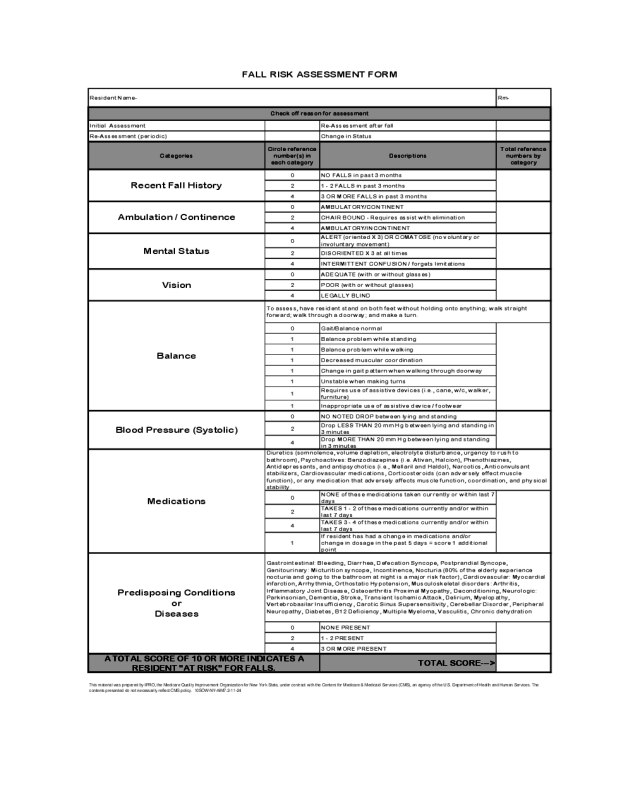Fillable Printable Fall Risk Assessment Sample Form
Fillable Printable Fall Risk Assessment Sample Form

Fall Risk Assessment Sample Form

FALL RISK ASSESSMENT FORM
Rm-
Initial Assessment Re-Assessment after fall
Re-Assessment (periodic) Change in Status
Categories
Circle reference
number(s) in
each category
Descriptions
Total reference
numbers by
category
0 NO FALLS in past 3 months
2 1 - 2 FALLS in past 3 months
4 3 OR MORE FALLS in past 3 months
0 AMBULATORY/CONTINENT
2 CHAIR BOUND - Requires assist with elimination
4 AMBULATORY/INCONTINENT
0
ALERT (oriented X 3) OR COMATOSE (no voluntary or
involuntary movement)
2 DISORIENTED X 3 at all times
4 INTERMITTENT CONFUSION / forgets limitations
0 ADEQUATE (with or without glasses)
2 POOR (with or without glasses)
4 LEGALLY BLIND
0 Gait/Balance normal
1 Balance problem while standing
1 Balance problem while walking
1 Decreased muscular coordination
1 Change in gait pattern when walking through doorway
1 Unstable when making turns
1
Requires use of assistive devices (i.e., cane, w/c, walker,
furniture)
1 Inappropriate use of assistive device / footwear
0 NO NOTED DROP between lying and standing
2
Drop LESS THAN 20 mm Hg between lying and standing in
3 minutes
4
Drop MORE THAN 20 mm Hg between lying and standing
in 3 minutes
0
NONE of these medications taken currently or within last 7
days
2
TAKES 1 - 2 of these medications currently and/or within
last 7 days
4
TAKES 3 - 4 of these medications currently and/or within
last 7 days
1
If resident has had a change in medications and/or
change in dosage in the past 5 days = score 1 additional
point
0 NONE PRESENT
2 1 - 2 PRESENT
4 3 OR MORE PRESENT
TOTAL SCORE--->
This material was prepared by IPRO, the Medicare Quality Improvement Organization for New York State, under contract with the Centers for Medicare & Medicaid Services (CMS), an agency of the U.S. Department of Health and Human Services. The
contents presented do not necessarily reflect CMS policy. 10SOW-NY-AIM7.2-11-24
Ambulation / Continence
Vision
Balance
Blood Pressure (Systolic)
Diuretics (somnolence, volume depletion, electrolyte disturbance, urgency to rush to
bathroom), Psychoactives: Benzodiazepines (i.e. Ativan, Halcion), Phenothiazines,
Antidepressants, and antipsychotics (i.e., Mellaril and Haldol), Narcotics, Anticonvulsant
stabilizers, Cardiovascular medications, Corticosteroids (can adversely effect muscle
function), or any medication that adversely affects muscle function, coordination, and physical
stability.
To assess, have resident stand on both feet without holding onto anything; walk straight
forward; walk through a doorway; and make a turn.
Resident Name-
Check off reason for assessment
A TOTAL SCORE OF 10 OR MORE INDICATES A
RESIDENT "AT RISK" FOR FALLS.
Mental Status
Medications
Predisposing Conditions
or
Diseases
Gastrointestinal: Bleeding, Diarrhea, Defecation Syncope, Postprandial Syncope,
Genitourinary: Micturition syncope, Incontinence, Nocturia (80% of the elderly experience
nocturia and going to the bathroom at night is a major risk factor), Cardiovascular: Myocardial
infarction, Arrhythmia, Orthostatic Hypotension, Musculoskeletal disorders: Arthritis,
Inflammatory Joint Disease, Osteoarthritis Proximal Myopathy, Deconditioning, Neurologic:
Parkinsonian, Dementia, Stroke, Transient Ischemic Attack, Delirium, Myelopathy,
Vertebrobasilar Insufficiency, Carotic Sinus Supersensitivity, Cerebellar Disorder, Peripheral
Neuropathy, Diabetes, B12 Deficiency, Multiple Myeloma, Vasculitis, Chronic dehydration
Recent Fall History



